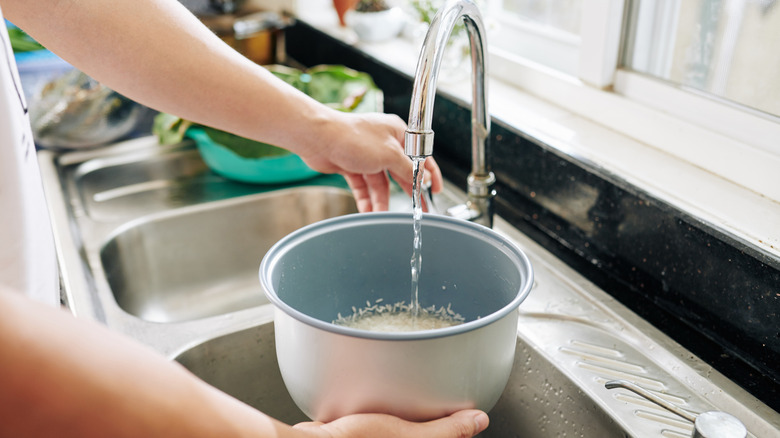Why You Should Never Use Hot Tap Water For Cooking
When you're in a hurry to boil pasta, make Jell-O, or get the French press going, it might seem harmless (efficient even) to fill your pot with hot water straight from the tap. But using hot tap water for cooking isn't just a bad culinary habit, it can actually be a health hazard. From hidden contaminants to outdated plumbing, the reasons to avoid this shortcut are surprisingly under-discussed. Tap water, in general, is treated to be safe for drinking, but the path it travels before it reaches your pot matters. When you turn on the hot tap, the water you're getting has probably spent quite a bit of time sitting in your home's hot water heater. And that's where the problem starts.
Water heaters naturally accumulate sediment over time. If it isn't set hot enough, bacteria can also grow in the warm, stagnant environment. If you need to hear it from the experts, the EPA even explicitly says so: "Never use water from the hot water tap for drinking, cooking, or making baby formula." Hot water cornbread, beans which require soaking, and rice are all dishes that absorb water as part of the cooking process. The quality of your cooking water directly impacts the final dish and contaminants in hot tap water aren't always destroyed by boiling. Some heavy metals (like lead) and other chemical compounds can persist even after you've reached a rolling boil. So, if you wouldn't drink it straight from the hot tap, don't use it to cook something that absorbs that water entirely.
Cold tap water tastes better
Unlike cold water pipes, which usually deliver water fresh from your municipality or other water source, hot water systems can leach metals, especially in older homes. If your plumbing contains lead pipes or solder, hot water is far more likely to dissolve and carry those metals compared to cold water. And while technically modern regulations have phased out lead in new plumbing, plenty of homes still have older materials that can pose risks. A bit more on modern pipes: In 2011, Congress reduced the maximum allowable lead content to 0.25% in new pipes — not zero. That teeny amount still carries a risk with hot tap water.
While we're on the subject of contaminants, if you live in an older building or have been traveling, you'll also want to flush your taps. It's a good idea to run the tap for 30 seconds to 2 minutes before using it for drinking or cooking. You can use this water for houseplants or boil it to transform a can of sweetened condensed milk into dulce de leche. There's also a culinary case for using cold tap water: taste. Water drawn from a hot tap can pick up off-flavors from old pipes, rubber washers, or the water heater itself. Those subtly yucky notes can linger in tea, coffee, broths, and pasta water; affecting the overall flavor of the dish. For safer and cleaner food and beverages, cold tap water is always the best choice.

